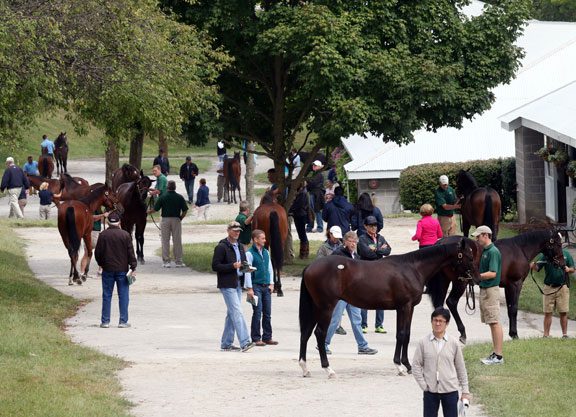By Bill Oppenheim
When all the cajoling, chirping, and yipping had died down Monday night at the end of Book 3, the needle hadn't moved at all. Last year (8 sessions) 1,588 yearlings sold in Books 1-3 for a total of $245,951,500, an average of $154,881 per horse. This year (7 sessions) 1,504 yearlings sold in the first three books totaled $245,570,500, an average of $163,278 per horse. Five percent fewer horses sold for almost the exact same amount of money, and the average rose by five percent. The Book 1-3 gross in 2015 was $381,000 lower than in 2014, or roughly $250 per horse sold this year; in other words, the difference in gross was less than negligible.
You'll recall that in Book 1 last week, the gross dropped by a little under $7.8-million, or 5%, from 2014; the number sold was down by 7%, and the average edged up by 1%. Taken together, Books 2-3 were stronger, though there was a blip on Sunday, which was the first day of Book 3. On Sunday the median dropped by 21% from the corresponding session last year ($70,000 to $55,000), though the Monday session (day two of Book 3) was actually up 25% on average from the corresponding 2014 session; in fact, very unusually, the average on the second day of Book 3 this year (Monday, $77,906) was over $4,000 higher than the first day (Sunday, $73,752), and the gross was almost $1.4-million higher.
Notwithstanding that little wrinkle, Book 2 and 3 combined–'the middle market', shall we say?–gained in gross and average from 2014. The number of horses catalogued in Book 2-3 this year (1,609) was virtually the same as last year (1,617), but the number sold was down 5%, from 1,115 to 1,061, meaning the clearance rate from the catalogues (subtracting withdrawals and not-solds) was down three points, from 68.9% last year to 65.9% this year. But gross revenues increased by $7.4-million, or 7%, from $103,798,500 last year to $111,209,500 this year; and the Book 2-3 average was up 12%, from $93,092 in 2014, to $104,815 this year. If Book 1 is a catalogue of $300,000 yearlings, Books 2-3 are catalogues of more than a thousand $100,000 yearlings.
The importance of the Books 2-3 'middle' market is demonstrated by this statistic: if you look at the first three books combined, 71% of those yearlings sold in Books 2-3 and contributed 45% of the revenues. The more select Book 1 supplied 55% of the revenues from just 29% of the horses, but the really significant number there is that Books 2-3 constitute 45% of the first $245-million of yearlings sold. That's a very important constituent of the yearling marketplace, certainly in the number of yearlings sold (1,061 in Books 2-3) as well as providing $111-million in revenues. So the fact that this sector of the market is up 7% in gross, though the number sold did fall by 5%, is good news for breeders. But breeders and stallion owners alike also know that single-digit increases in gross while the number and percentage sold actually fall are not going to justify across-the-board increases in stud fees. Of course, the stud fees will go up on the likes of Scat Daddy and Curlin, but it's hard to imagine breeders looking at these numbers and signing up to many increases.
The Instatistics table that ran yesterday (click here) shows that, for all yearlings sold this year in North America through Book 3, Gainesway's Tapit (41, avg. $620,297) leads Claiborne's War Front (24, avg $574,375) by year-to-date yearling average so far. But there is also something to be said for taking a snapshot of what happened in the previous seven days– Keeneland Books 1-3. At Keeneland alone, War Front had 21 sell in Books 1-3, for an average of $600,714; Tapit had 32 sell, for an average of $526,875. Whichever way you look at it, Tapit and War Front are out on their own as North America's top two commercial sires.
Taking only sires which had eight or more sell in Keeneland Books 1-3: Darley's Medaglia d'Oro has been a consistent top sire, both commercially and on the racetrack the past several years, and has been number three on average through the first three books, with 33 averaging $343,788. WinStar's Distorted Humor (31 avg $315,806) is as strong as ever, and Hill 'n' Dale's new recruit Curlin, with his $975,000 Book 3 filly, had eight average $309,625 through Monday. Four other sires averaged in the 200's during Keeneland's first seven days: Darley's Bernardini ($265,059); Lane's End's deceased Smart Strike ($255,455); WinStar's Speightstown ($231,536); and Darley's deceased Street Cry ($228,286). Spendthrift's Malibu Moon had 37 average $193,378 in the first three books, inches ahead of WinStar's Pioneerof the Nile, who had 30 average $193,300.
WinStar's Bodemeister led first-year sires through Keeneland's first seven days, with 44 yearlings averaging $189,545. Lane's End's The Factor has achieved 'market darling' status, between Saratoga and Keeneland, and in Books 1-3 he had 34 yearlings average $145,176, edging out Lane's End barn-mate Union Rags, who had 36 average $136,222. Gainesway's Tapizar also cracked the six-figure barrier among first-year sires with eight or more sold; he had 23 average $113,130. The judges say he is throwing a big, strong, likable type.
A few other notable Books 1-3 averages: Ashford's Scat Daddy, having a breakthrough year–31, averaged $179,903. Claiborne's Flatter–21, averaged $163,810; Ashford's leading freshman sire, Uncle Mo–27, averaged $142,714. Top commercial sires with first 3-year-olds, again with 8+ sold in the first three books: Lane's End's Quality Road (21, averaged $152,762) and Claiborne's Blame (27, averaged $134,648). And Spendthrift's seriously up-and-coming Into Mischief, from his first big crop: 29, averaged $128,759.
We'll be back next Monday with a recap of the entire Keeneland sale, then it's on to Goffs and Tatteralls October for the European Majors.
Not a subscriber? Click here to sign up for the daily PDF or alerts.





